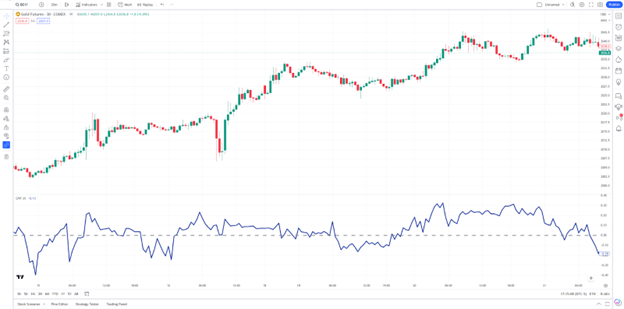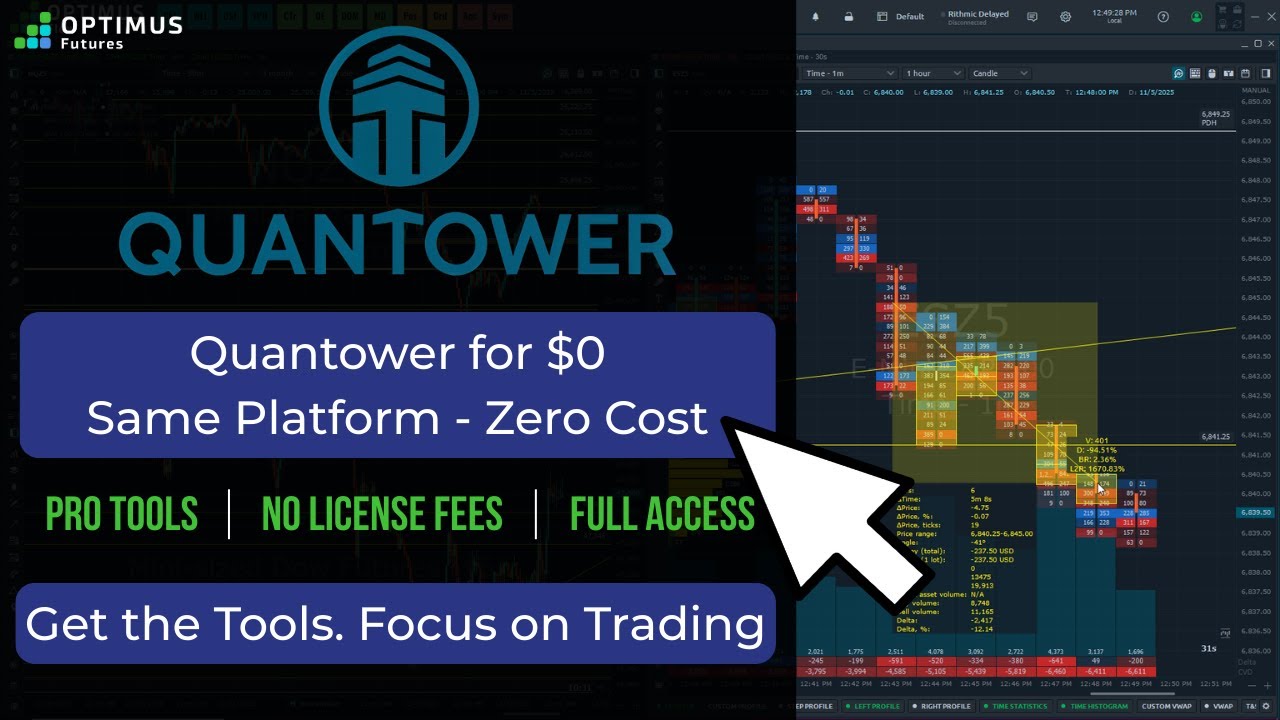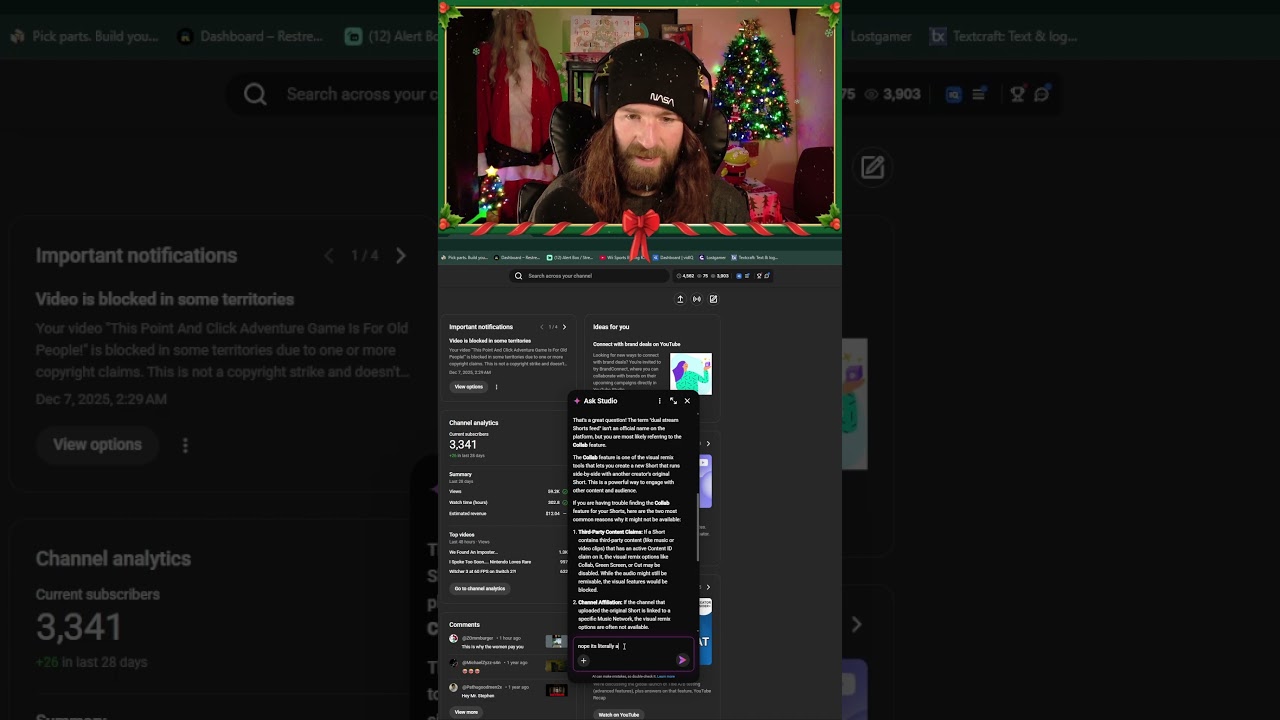The article on Best Volume Indicators on TradingView is the opinion of Optimus Futures, LLC.
If price is the heartbeat of day trading, then volume is the blood pressure.
Sure, doctors care about keeping your ticker pumping. But they also know blood pressure that’s too high or low could be a harbinger of problems down the road.
Price and volume work the same way.
Yet, too many traders never take advantage of the tools available.
They restrict themselves to a chart with a volume histogram added at the bottom.
We may buy and sell at the prevailing price. But, analyzing the volume provides crucial insights into the strength and potential of market movements.
That’s why we’re going to introduce you to what we consider the five best volume indicators in Tradingview for day trading.
Some of these overlap with our 4 Best Tradingview Indicators for Day Trading.
However, each indicator below offers a unique perspective on the market and can be easily integrated with one another and other types of analysis.
#1 Volume Profile
Imagine you enter an open air market to buy apples.
You learn that just before you got there, 10 people bought an apple at $1.00 while 1,000 people bought an apple at $2.00.
How much do you think you’ll be able to buy an apple for?
You might get lucky and find a TJ Maxx-type deal on an apple for $1.00. But chances are you’ll be stuck with the $2.00 price.
If you plotted the price and volume of those transactions as a horizontal histogram, you’d get a volume profile.
On an S&P 500 E-Mini Futures chart, it would look something like this:
You get a horizontal histogram overlaid onto the price chart.
This indicator contains three key pieces of information:
- Point of Control (POC): The price level boasting the highest traded volume, often highlighted with a red line, acts as a magnet for future price action.
- Profile Extremes: The lowest (Profile Low) and highest (Profile High) prices traded within the period under review.
- Value Area: Encompassing the range where a significant majority of trading volume occurred—usually 70%—this area is demarcated by the Value Area High and Low (dark shading vs light shading), serving as a barometer for market consensus on value.
Analyzing this, we see the POC lands at $4990.25. It’s our $2.00 apple area.
Price will often move away from low-value areas, and towards the point of control and high-value areas in the same way the odds of you buying an apple at a price between $1.00 and $2.00 would play out.
Day traders often use the POC, the edges of the value area, and profile extremes as support and resistance levels to frame their trades.
For example. Let’s say the ES Futures move back towards $5000.
We can see this is outside the value area and moves into a low-volume node.
A trader may use this to fade that price, betting it would move back towards $4990.
Volume Profiles are a unique indicator you can explore through Tradingview and are particularly useful if you want to trade order flow.
You can also dig even deeper by exploring different volume profile shapes.
#2 Volume Weighted Average Price (VWAP)
Have you ever wondered how floor traders on the New York Stock Exchange are evaluated?
One common method is to look at their average execution price against the volume-weighted average price (VWAP).
VWAP represents the average price for an asset weighted by volume across a time period.
You’ve probably seen this yourself if you bought one ES contract at say $4900 and one at $4850. Your VWAP (average price) would be $4875.
VWAP is an incredibly powerful tool used by traders to compare themselves to the rest of the market.
It’s a fantastic tool to measure sentiment. Plus, day traders will use VWAP as support or resistance directly.
Here’s an example of how you might use it.
This is a 15-minute chart of the S&P 500 E-Mini Futures. The blue line represents VWAP.
Notice how ES Futures price sank below VWAP around [12:00] on the 19th. It never got back above.
Effectively, traders were willing to sell ES Futures at a price worse than the average.
If you’re willing to do that, you’ve clearly got a bearish outlook.
Next, look at the candlestick right at the New York Open on the 20th.
See how ES Futures ran up into VWAP and then reversed?
The same thing happened later in the day, around [15:00].
While these types of price reactions aren’t guaranteed, if you study charts of everything from futures to stocks, you’ll see it happen more often than randomness could account for.
On Balance Volume
It’s easy enough to identify price jumps and plunges on heavy volume.
All you have to do is look for a quick price change and a spike in volume.
But how do you know if the volume is a lot relative to recent history?
That’s where On Balance Volume (OBV) becomes immensely helpful.
OBV starts with a baseline. It then adds volume when the candlestick closes positive and subtracts volume when the candlestick closes down.
That might not sound all that useful. But let’s look at an example using gold futures. The blue line at the bottom represents OBV.
This chart shows the price of gold futures drop and keep moving lower.
Similarly, the OBV drops. However, it doesn’t keep sliding lower the way price does. It’s far more stable.
If you look at the spot noted by the arrows, you’ll see that while Gold Futures are making substantially lower prices, OBV is only a touch lower.
Essentially, it’s telling us that the price of gold is moving lower on waning volume and actually precedes the price reversal.
Day traders use OBV to look for divergences to give them clues about when the market might be due for a reversal.
They’ll also look at it for confirmation of a trend when both price and the OBV are moving in the same direction.
Accumulation Distribution (A/D)
Similar to OBV, the Accumulation Distribution (A/D) indicator tries to represent volume that’s either being accumulated (bought) or distributed (sold).
The difference is in how the two are calculated.
OBV simply looks at whether the close of one period is above or below the prior period’s close, adding or subtracting the volume accordingly.
The A/D indicator does the same thing except adding volume when it closes in the upper half of the day’s range and subtracting it when it closes in the lower half.
While these indicators often provide similar signals, they will diverge, especially when there are gaps in price.
Just like the OBV, day traders will use the A/D indicator to look for divergences and trend confirmations.
The gold futures chart below highlights a clean example when price diverges from the A/D indicator.
In this example, gold futures drop rather severely. Yet, the A/D line barely budges, and in fact moves higher.
This is a bullish divergence, where traders may buy gold assuming the overall trend is intact and the A/D line’s divergence signals traders are actually buying the dip.
Chaikin Money Flow
Last on our list is the Chaikin Money Flow (CMF).
Like OBV and A/D, CMF measures volume buying and selling over time.
However, while the A/D is a cumulative metric, CMF normalizes the volume by comparing the Money Flow Volume (which adjusts the day’s volume based on the close’s position within the high-low range) to the total volume over a given time, usually 20 or 21 periods.
This normalization process makes the CMF less sensitive to one-day volume spikes and better at discerning price reversals and trends that are more sustainable.
The CMF is measured on a range from -1 to +1 or -100 to +100 with a zero line drawn down the middle.
Let’s take a look at the gold futures below, with the CMF at the bottom.
In this chart, persistent CMF readings over the zero line indicate buying pressure.
If the CMF were to spend as much time under the zero line as over it, we’d have no real conviction one way or the other based on volume.
You can also use the CMF to spot divergences since money flow and price movement should be correlated.
So, if a stock rallies while the CMF remains below the zero line, it may indicate an opportunity to fade the move and short the market.
Final Considerations
Mastering volume indicators can be a day trading game-changer.
But their true value comes when you integrate them into a broader analysis.
The five key tools we’ve unpacked—Volume Profile, VWAP, OBV, A/D, and CMF—unlock deep market insights you won’t get from typical price indicators like moving averages or Bollinger Bands.
Yet, they only scratch the surface of what’s available.
That’s why we encourage you to explore the dozens of volume indicators available on TradingView’s platform.
Best of all, Optimus Futures offers a bespoke integration with TradingView to deliver you with a best-in-class experience. Click Here to Learn More.
Trading in futures involves a significant risk of loss and is not suitable for all investors. Past performance is not necessarily indicative of future results. Any use of external indicators or downloaded materials is at the user’s own risk. The information provided herein is intended solely for educational purposes and does not constitute investment advice. Optimus Futures does not endorse or assume responsibility for the content or services of any external links referenced. The placement of contingent orders by you or broker, or trading advisor, such as a “stop-loss” or “stop-limit” order, will not necessarily limit your losses to the intended amounts, since market conditions may make it impossible to execute such orders.









